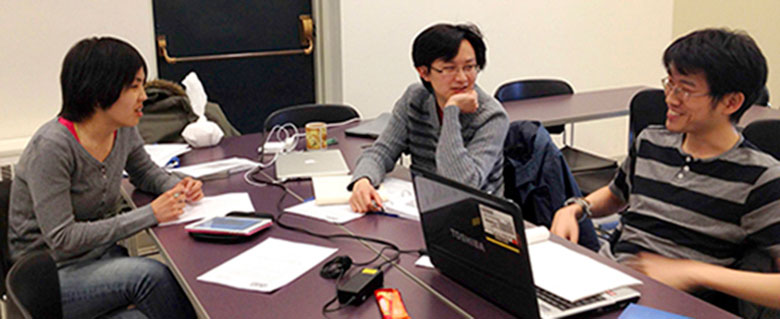Preparing Undergraduates for Astronomical Research
“Why are your error bars so small?”
Team:
Tuan Do (Lead), Dunlap Institute postdoctoral researcher astrophysics
Jeffrey Fung, University of Toronto graduate student in astronomy
Etsuko Mieda, University of Toronto graduate student in astronomy
Audience:
17 undergraduates just about to begin summer research experience in astronomy
Venue:
PREP at the Dunlap Institute or the Canadian Institute for Theoretical Astrophysics, University of Toronto, Canada. May 6-8, 2013
Description:
The goals of this activity are for students to learn about Gaussian errors and to practice designing investigations. The inquiry activity involves determining the minimum number of measurements necessary to draw conclusions about three astronomical problems: (1) finding a galaxy cluster; (2) determining Hubble’s constant; and (3) measuring the period of a planet. The students learn about each of the problems as they rotate through three “starter” stations, and they are asked to brainstorm ideas for approaching the problem. For example, at the galaxy cluster starter they are shown an image of galaxies, and told that galaxies are not uniformly distributed in the sky, and can be in clusters. The problem posed to the students is to confirm that there is a galaxy cluster and figure out its distance. They are told that the data available to explore this problem includes positions, magnitudes, and redshifts.
After rotating through all three stations, students choose a problem and work in a small team over a period of about seven hours (spread over two days). First they are given printed datasets to work with for about an hour and are asked to plan an investigation and the number of required measurements. Before moving forward to the computers, the facilitators ask the students to articulate the goals of their plans and how they would implement them on the computer. They also defended how they would arrive at a minimum number of measurements. The students then have about six hours to work on computers with datasets that they can explore in different ways. The students were provided with some brief training in plotting and basic programming. Analyses that require advanced programs were pre-written and made available to the students when necessary. The students meet with other teams investigating the same problem midway through the investigation to discuss their approaches and their plans for the second half. At the end of the activity students present their results, including plots, and must defend the number of measurements they chose in relation to their conclusion.
The team intentionally designed their activity to create an equitable environment by: 1) providing different pathways for learning; 2) giving students a feeling of being part of a scientific community; and 3) providing them with different ways to express their ideas. Instructors noted that students approached their investigations in many ways. For example, some looked at their galaxy distributions in the plane of the sky while others looked at redshifts. They also came up with different definitions of a galaxy cluster. Students had multiple opportunities to share their findings with their peers, and even kept discussing and debating during their lunch break. From the beginning, students were encouraged to express their ideas in different ways, and instructors observed students justifying their solutions with plots, equations, figures, in writing, and verbally.
Additional activities at venue:
Networking; role play on how to effectively work with mentors; computer session
Sponsor: |
ISEE staff consultant:
Lisa Hunter
Immediate Impacts
Learning outcomes from activity: Students were assessed based on how they used Gaussian errors to report on their results. A rubric was created, and students were scored on how they reported uncertainty, used histograms, and defended the number of measurements chosen. A total score of 8 was a proficient understanding (12 if students showed a nuanced understanding of all aspects), and students’ scores ranged from 5.5-8. Students’ proficiency in planning an investigation with optimal measurements was observed and facilitated; those that demonstrated proficiency were able to justify their plan (not use trial and error) and optimize their measurements.
How students responded to activity:
"Working on the problem from scratch gave me, personally, a sense of responsibility and independence in my project (not being told what to do and how to do it). I really liked that we were "answered with more questions" because it taught me to really think for myself and how to work through a problem truly on my own terms with my partner."
"Also, we chased what ended up as a dead-end for a while - somehow the fact that we're not streamlined into the 'right' conclusion leads to a much more interesting and valuable session."
Long-term Impacts
Venue: PREP (Preparation for Research Experiences Program) is an ISEE program that can be tailored to the needs of a partner site and is based on a 5-day short course that was developed by the Center for Adaptive Optics education program, now run by ISEE.
PDP team members: too recent to report on at this date

